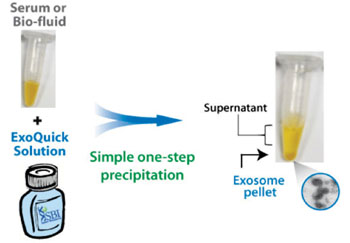Derived Exosomal Protein Biomarkers in Alzheimer’s Disease Diagnosis
|
By LabMedica International staff writers Posted on 04 Aug 2016 |

Image: The ExoQuick preparation method obtains high-quality exosomes from most biofluids using a protocol that can easily be performed on multiple samples and requires very low volumes of input sample (Photo courtesy of System Biosciences).
Alzheimer’s disease results in brain neuronal plaques composed of amyloid beta peptide (Aβ42) and neurofibrillary tangles composed of phosphorylated tau proteins (P-T181-tau and P-S396-tau). Exosomes are shed by brain neurons, freely cross the blood brain barrier and protect and carry proteins from their cellular origin into plasma.
P-T181-tau and P-S396-tau are present at higher than normal concentrations and Aβ42 at lower than normal concentrations in the cerebrospinal fluid of Alzheimer’s disease (AD) patients. These proteins are not high in plasma samples of AD patients in part due to poor blood brain barrier transport and protease activities.
Scientists at Pan Laboratories (Irvine, CA, USA) and their colleagues validated enzyme-linked immunosorbent assays (ELISA) for Aβ42, P-T181-tau and P-S396-tau, and used them to quantify these proteins in neuron-derived exosomal extracts from normal and AD plasma samples. Plasma samples were obtained from patients with mild cognitive impairment (MCI) and dementia due to Alzheimer’s disease (AD), as well as matched normal controls. Exosomes were precipitated from the plasma samples using the ExoQuick preparation (System Biosciences, Palo Alto, CA, USA).
The team reported that ELISA assays for Aβ42, P-T181-tau and P-S396-tau were reproducible and the Inter-assay Coefficient of Variability (CV) was less than 15%. The sensitivity of the biomarker ELISAs varied from 2 to10 pg/mL. Neuron-specific exosomes were prepared from the plasma of normal controls, MCI and AD patients. The reproducibility of the exosome preparations and biomarker levels were monitored in each ELISA. All biomarkers were elevated in MCI patients and AD patients compared to normal.
The authors concluded that they have validated a reproducible procedure to isolate specific neuron-derived exosomes for quantification of specific protein biomarkers in plasma samples. The concentrations of the biomarkers are high in patients with early dementia and Alzheimer’s disease. This procedure may be useful in the early diagnosis of Alzheimer’s disease. The study was presented at the 68th American Association of Clinical Chemistry (AACC) Annual Scientific Meeting held July 31 to August 4, 2016, in Philadelphia, PA, USA.
Related Links:
Pan Laboratories
System Biosciences
American Association of Clinical Chemistry
P-T181-tau and P-S396-tau are present at higher than normal concentrations and Aβ42 at lower than normal concentrations in the cerebrospinal fluid of Alzheimer’s disease (AD) patients. These proteins are not high in plasma samples of AD patients in part due to poor blood brain barrier transport and protease activities.
Scientists at Pan Laboratories (Irvine, CA, USA) and their colleagues validated enzyme-linked immunosorbent assays (ELISA) for Aβ42, P-T181-tau and P-S396-tau, and used them to quantify these proteins in neuron-derived exosomal extracts from normal and AD plasma samples. Plasma samples were obtained from patients with mild cognitive impairment (MCI) and dementia due to Alzheimer’s disease (AD), as well as matched normal controls. Exosomes were precipitated from the plasma samples using the ExoQuick preparation (System Biosciences, Palo Alto, CA, USA).
The team reported that ELISA assays for Aβ42, P-T181-tau and P-S396-tau were reproducible and the Inter-assay Coefficient of Variability (CV) was less than 15%. The sensitivity of the biomarker ELISAs varied from 2 to10 pg/mL. Neuron-specific exosomes were prepared from the plasma of normal controls, MCI and AD patients. The reproducibility of the exosome preparations and biomarker levels were monitored in each ELISA. All biomarkers were elevated in MCI patients and AD patients compared to normal.
The authors concluded that they have validated a reproducible procedure to isolate specific neuron-derived exosomes for quantification of specific protein biomarkers in plasma samples. The concentrations of the biomarkers are high in patients with early dementia and Alzheimer’s disease. This procedure may be useful in the early diagnosis of Alzheimer’s disease. The study was presented at the 68th American Association of Clinical Chemistry (AACC) Annual Scientific Meeting held July 31 to August 4, 2016, in Philadelphia, PA, USA.
Related Links:
Pan Laboratories
System Biosciences
American Association of Clinical Chemistry
Latest AACC 2016 News
- Molecular Test Detects Three Arboviruses in Plasma Samples
- New Biochip Array Developed for ApoE4 Classification
- Cell-Free DNA Identifies Liver Transplant Patients with Acute Rejection
- New Method Tested for Early Diagnosis Pediatric Diabetic Nephropathy
- FDA-Cleared Automated Cell Counter for CSF Launched at AACC 2016
- Semen Analysis Portfolio with Two New Products Featured at AACC 2016
- Automation Solutions for Clinical Diagnostic Equipment Showcased at AACC 2016
- New Tubes Designed for Medium Sample Volumes
- Multi Sample Osmometer Improves Testing Efficiency
- Innovative Information System Optimizes Laboratory Processes
- Innovative eLearning Interface Seamlessly Connects Competency Data
- Cloud-Based Connectivity Platform Advances Decentralized Healthcare
- Adhesives Research to Present Hydrophilic Adhesive Technologies
- Point-of-Care Immunoassay Analyzer on Display at AACC Annual Meeting
- Assay for Determination of 17-OH Progesterone to Be Featured at AACC Annual Meeting
- Fully Automated HbA1c Analyzer Available for Inspection at AACC Annual Meeting
Channels
Clinical Chemistry
view channel
Gold Nanoparticles to Improve Accuracy of Ovarian Cancer Diagnosis
Ovarian cancer is considered one of the deadliest cancers, in part because it rarely shows clear symptoms in its early stages, and diagnosis is often complex. Current approaches make it difficult to accurately... Read more
Simultaneous Cell Isolation Technology Improves Cancer Diagnostic Accuracy
Accurate cancer diagnosis remains a challenge, as liquid biopsy techniques often fail to capture the complexity of tumor biology. Traditional systems for isolating circulating tumor cells (CTCs) vary in... Read moreMolecular Diagnostics
view channel
Routine Blood Draws Could Detect Epigenetic Biomarkers for Predicting Cardiovascular Disease Risk
Cardiovascular disease is a leading cause of death worldwide, yet predicting individual risk remains a persistent challenge. Traditional risk factors, while useful, do not fully capture biological changes... Read more
Single Cell RNA Sequencing Could Enable Non-Invasive Blood Disorder Diagnosis
Hematologic disorders are often diagnosed using painful, invasive, and expensive bone marrow aspiration or biopsy procedures. These approaches limit patient compliance and broader utility, leaving a need... Read more
Blood Test Identifies HPV-Associated Head and Neck Cancers 10 Years Before Symptoms
Human papillomavirus (HPV) causes around 70% of head and neck cancers in the United States, and cases are rising each year. Unlike cervical cancers linked to HPV, there is currently no screening test for... Read moreHematology
view channel
Pioneering Model Measures Radiation Exposure in Blood for Precise Cancer Treatments
Scientists have long focused on protecting organs near tumors during radiotherapy, but blood — a vital, circulating tissue — has largely been excluded from dose calculations. Each blood cell passing through... Read more
Platelets Could Improve Early and Minimally Invasive Detection of Cancer
Platelets are widely recognized for their role in blood clotting and scab formation, but they also play a crucial role in immune defense by detecting pathogens and recruiting immune cells.... Read more
Portable and Disposable Device Obtains Platelet-Rich Plasma Without Complex Equipment
Platelet-rich plasma (PRP) plays a crucial role in regenerative medicine due to its ability to accelerate healing and repair tissue. However, obtaining PRP traditionally requires expensive centrifugation... Read moreImmunology
view channel
Companion Diagnostic Test Identifies HER2-Ultralow Breast Cancer and Biliary Tract Cancer Patients
Breast cancer is the most common cancer in Europe, with more than 564,000 new cases and 145,000 deaths annually. Metastatic breast cancer is rising in younger populations and remains the leading cause... Read more
Novel Multiplex Assay Supports Diagnosis of Autoimmune Vasculitis
Autoimmune vasculitis and related conditions are difficult to diagnose quickly and accurately, often requiring multiple tests to confirm the presence of specific autoantibodies. Traditional methods can... Read more
Blood Test Predicts Immunotherapy Efficacy in Triple-Negative Breast Cancer
Triple-negative breast cancer (TNBC) is an aggressive subtype lacking targeted therapies, making immunotherapy a promising yet unpredictable option. Current biomarkers such as PD-L1 expression or tumor... Read more
Simple Genetic Testing Could Predict Treatment Success in Multiple Sclerosis Patients
Multiple sclerosis (MS) patients starting therapy often face a choice between interferon beta and glatiramer acetate, two equally established and well-tolerated first-line treatments. Until now, the decision... Read moreMicrobiology
view channel
Microfluidic Platform Assesses Neutrophil Function in Sepsis Patients
Sepsis arises from infection and immune dysregulation, with neutrophils playing a central role in its progression. However, current clinical tools are unable to both isolate these cells and assess their... Read moreNew Diagnostic Method Confirms Sepsis Infections Earlier
Sepsis remains one of the most dangerous medical emergencies, often progressing rapidly and becoming fatal without timely intervention. Each hour of delayed treatment in septic shock reduces patient survival... Read more
New Markers Could Predict Risk of Severe Chlamydia Infection
Chlamydia trachomatis is a common sexually transmitted infection that can cause pelvic inflammatory disease, infertility, and other reproductive complications when it spreads to the upper genital tract.... Read more
Portable Spectroscopy Rapidly and Noninvasively Detects Bacterial Species in Vaginal Fluid
Vaginal health depends on maintaining a balanced microbiome, particularly certain Lactobacillus species. Disruption of this balance, known as dysbiosis, can increase risks of infection, pregnancy complications,... Read morePathology
view channelAccurate Pathological Analysis Improves Treatment Outcomes for Adult Fibrosarcoma
Adult fibrosarcoma is a rare and highly aggressive malignancy that develops in connective tissue and often affects the limbs, trunk, or head and neck region. Diagnosis is complex because tumors can mimic... Read more
Clinicopathologic Study Supports Exclusion of Cervical Serous Carcinoma from WHO Classification
High-grade serous carcinoma is a rare diagnosis in cervical biopsies and can be difficult to distinguish from other tumor types. Cervical serous carcinoma is no longer recognized as a primary cervical... Read moreTechnology
view channel
Coral-Inspired Capsule Samples Hidden Bacteria from Small Intestine
The gut microbiome has been linked to conditions ranging from immune disorders to mental health, yet conventional stool tests often fail to capture bacterial populations in the small intestine.... Read more
Rapid Diagnostic Technology Utilizes Breath Samples to Detect Lower Respiratory Tract Infections
Respiratory tract infections (LRTIs) are leading causes of illness and death worldwide, particularly among vulnerable populations such as the elderly, young children, and those with compromised immune systems.... Read moreIndustry
view channel
Werfen and VolitionRx Partner to Advance Diagnostic Testing for Antiphospholipid Syndrome
Antiphospholipid syndrome (APS) is a rare autoimmune disorder that causes the immune system to produce abnormal antibodies, making the blood “stickier” than normal. This condition increases the risk of... Read more





















